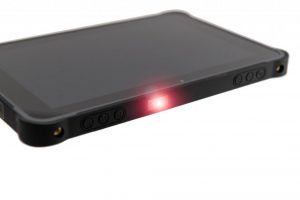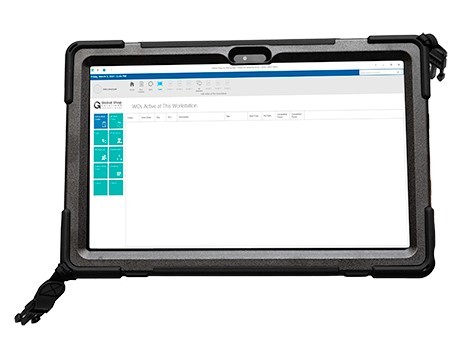There’s no dispute about the fact that using tablets can help reduce data entry errors and boost productivity — unless your devices aren’t made for work.
Per the latest findings from VDC Research, the rugged tablet market is expected to reach almost $1 billion in the next two years (a 5.7% CAGR), and manufacturers and warehouses are a big part of that trend. One key driver of these purchases is the tens of thousands of legacy mobile devices running Windows CE or Windows Embedded Compact that are no longer supported and must be replaced. Plus, there are thousands of warehouses across the country looking to make a move to mobile computing for the first time.
Whether you’re upgrading legacy devices or making a first-time purchase, there’s a critical question you need to answer: Should you buy consumer-grade tablets or rugged industrial tablets? Those opting for consumer devices cite initial cost savings along with familiar brand names and user interfaces for their decisions. Before you take their side, however, consider the following five points:
1. OS limitations. One feature that helps consumer tablet manufacturers keep their prices low is mass production, which necessitates limiting options (e.g., storage, RAM and wireless options, connectivity ports). One area in particular where this becomes problematic for businesses is with computer operating systems. With Apple’s iPads, for example, you’re married to their iPad OS, which is unlikely to support your WMS or inventory management software unless you jailbreak the tablets, which voids the warranty. Using cloud-based software that’s accessed via a browser is one way to overcome OS limitations. But, the downside of going all-in with the cloud is that you need to ensure your wireless network is robust enough to handle your bandwidth, security, and availability needs. If your wireless infrastructure isn’t up to par, the extra expenses must be factored into the total cost of your tablet investment.

2. Environmental suitability. What if you outfit a consumer tablet with a glass screen protector and rugged case — does that make it rugged? No, it does not. Here’s why: when a tablet falls off a desk or slips out of a user’s hand and impacts a hard surface, it isn’t just the outer shell that’s affected — the internal components and connectors are affected, too. Additionally, factors like dust, vibration, liquid spills, and extreme temperatures must be accounted for — all of which can wreak havoc on consumer tablets.
The points listed above lead to downtime and repair costs, which are part of the TCO (total cost of ownership) equation discussed in point five, below. There are additional environmental suitability points that fall into a different category, however. The first is screen brightness. Consumer tablets are designed for viewing in an indoor environment with controlled lighting. When used outside on a sunny day, the screens become unreadable. Rugged devices, on the other hand, have much brighter display capacities allowing viewing in all lighting conditions. Another screen-related concern is the touch technology. Most consumer devices use capacitive touchscreens, which are unresponsive when wearing gloves. Many rugged tablets, on the other hand, use resistive technology that responds to pressure, which works when wearing gloves. A third environmental suitability concern is battery life. Consumer tablets may have great battery life when doing light web browsing and word processing. But, when these same tablets are used for barcode scanning and other processor-intensive tasks, their batteries die way sooner — often before the end of a work shift. Because most consumer tablets don’t have hot-swappable batteries, the user must dock the tablet, which negates the benefits of being mobile.
3. Warranties and support. There’s a good chance your internal IT staff’s not equipped to fix a broken consumer-grade tablet screen, let alone a cracked chassis or malfunctioning motherboard. Most IT solution providers can’t help you either because the labor costs exceed the value of the device, making it an unfeasible business model. Also, the manufacturer may not honor their warranty if they discover the tablet is being used in an environment where it wasn’t designed to be used. Even if they do cover it, you can be sure that the turnaround time on getting your tablet repaired will be measured in weeks (or months) and not in days. If you’re thinking, “Yeah, but I could buy two or three consumer tablets for the price of one rugged tablet,” make sure to read point five below before making your final decision.
4. Peripheral connectivity. Consumer tablets are designed for watching movies, social media activities, and web surfing, not scanning barcodes and other business operations. This is evident in the lack of external ports (e.g., USB, micro USB, mini HDMI, RJ45) that support hardware add-ons used in a warehouse environment, such as scanners and scales. Additionally, rugged devices offer a more comprehensive range of wireless connectivity options such as Bluetooth 4.0, 4G LTE, 3G WCDMA, GSM, 802.11 a/b/c/g/n.
5. TCO (total cost of ownership). Rugged tablets indeed cost more than consumer-grade devices, but when you take into account the costs of consumer device repairs, support calls, and the biggest one — downtime — a rugged device costs less in the long run. Let’s take a look at the research to get a clearer picture of the differences. An IDC white paper: “Pay Now, Save Later: The Business Case for Rugged Devices,” takes an in-depth look at this topic and offers the following facts and conclusions:
- The average annual failure rate for consumer tablets is 15.7%.
- The average out-of-pocket cost to repair a tablet was $224.
- Employees list an average of 4.2 hours due to tablet repairs.
- For tablets, the most damaged component was the screen, followed by ports or connectors and then the outer chassis. (For many non-rugged tablets, these kinds of damages can’t be repaired, so the business would need to purchase another one).
- The top two causes of tablet damage were dropping the device, followed by spilling liquid on it.
- Respondents report paying $1,249 for non-rugged tablets versus $1,402 for rugged devices.
- After adding up annual break/fix support costs, out-of-pocket costs, lost productivity time, and IT time to manage and repair broken devices and recover data, IDC estimates the average cost associated with a non-rugged tablet is $2,462.
- Based on IDC’s findings, those who purchase rugged tablets achieve an ROI after the first year.
When IDC asked IT decision-makers if they intended to buy rugged tablets in the next 12 months, 27% said they were very likely, and another 12% said they were somewhat likely. Only about 8% of respondents indicated they were “very unlikely” or “somewhat unlikely” to buy rugged devices (the remaining respondents either didn’t respond to the question or were undecided). So, if you’re seriously considering rugged devices for your warehouse in the future, you’re in good company.
Conclusion
Smart manufacturers and warehousing companies have been using rugged tablets (and handhelds) for many years, and an increasing number are now discovering the benefits. One point to keep in mind is that these tablets aren’t necessary for a company’s entire workforce, but for a subset, such devices can lead to tangible benefits. And while rugged devices cost more than their non-rugged counterparts initially, after accounting for money saved with less employee downtime, lower IT support costs, and other cost savings, the investment in a high-quality, rugged tablet is the clear winner. A final thought to keep in mind is that rugged devices have come a long way in mimicking the look and feel that makes consumer devices so attractive to users. Companies looking to maximize their hardware investments would do well to take a long hard look at rugged devices the next time a hardware refresh is in order.
For more information, call us at 972-535-5555 or get a free consultation by clicking here.

